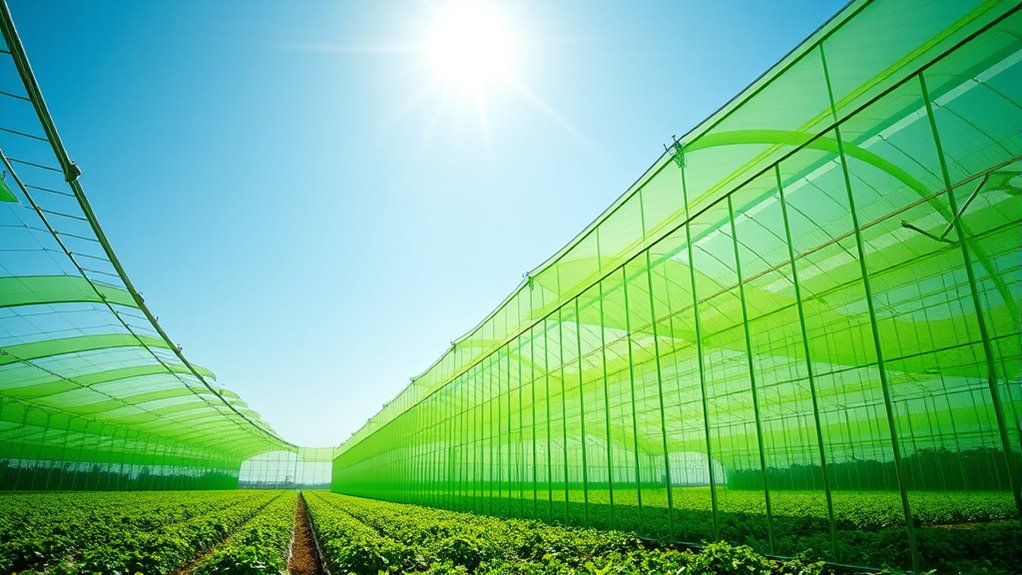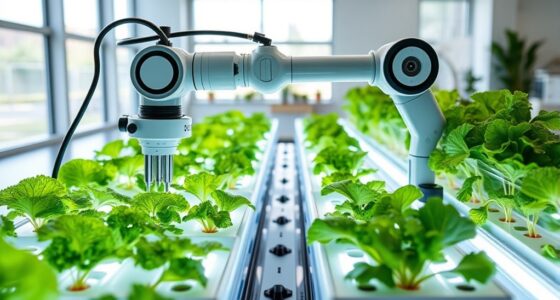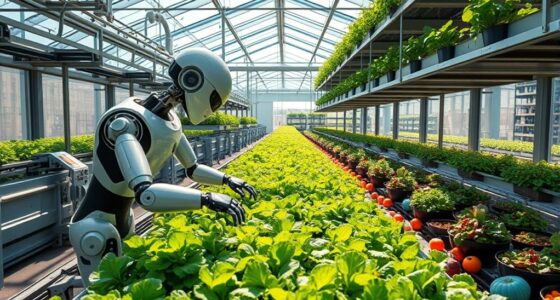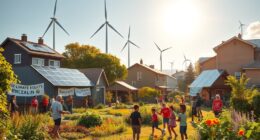Yes, you can print a farm using 3D-printed greenhouse structures. This innovative approach offers sustainable, customizable designs made from recycled or biodegradable materials. It speeds up construction, reduces waste, and allows for automation like climate control and irrigation. Plus, modular components let you adapt as your needs change. To explore how this technology is shaping future farms and what it can do for you, continue exploring the possibilities.
Key Takeaways
- 3D printing enables rapid, customizable construction of greenhouses, making farm setup faster and adaptable to specific needs.
- Incorporating automation during printing allows for self-regulating climate and irrigation systems, enhancing farm efficiency.
- Sustainable materials like recycled or biodegradable plastics reduce environmental impact of large-scale farm structures.
- Modular and intricate designs optimize sunlight exposure, ventilation, and water collection, improving crop yields.
- 3D-printed greenhouses support eco-friendly, resilient farming practices, offering a feasible approach to printing entire farms.

Have you ever wondered how technology can revolutionize agriculture? 3D-printed greenhouse structures are emerging as a sustainable and innovative solution to traditional farming challenges. By harnessing the power of additive manufacturing, you can design and construct customized greenhouses that are not only cost-effective but also environmentally friendly. This approach allows you to incorporate sustainable design principles, such as optimized material use and energy efficiency, making your farm more eco-conscious. Instead of relying on conventional building materials, you can choose biodegradable or recycled options, reducing your carbon footprint and promoting a circular economy. The flexibility of 3D printing means you can tailor the structure to your specific needs, whether it’s creating lightweight frameworks for easy transport or intricate designs that maximize sunlight exposure. Additionally, the precision of 3D printing ensures structural integrity and reduces waste, further supporting sustainable practices.
3D-printed greenhouses revolutionize farming with sustainable, customizable, and eco-friendly structures.
Integration of automation technology with 3D-printed greenhouses transforms the traditional farming process. You’re able to embed sensors, automated watering systems, and climate control mechanisms directly into the structure during printing. This seamless automation integration means your greenhouse can self-regulate temperature, humidity, and light levels, creating an ideal environment for your crops without constant manual intervention. The combination of sustainable design and automation reduces energy consumption and operational costs, making farming more efficient and sustainable in the long run. Plus, it enables you to monitor and manage your farm remotely, giving you greater control and flexibility over your agricultural practices.
Using 3D printing also speeds up the construction process. Instead of waiting weeks or months for traditional assembly, you can produce large sections or even entire structures in a fraction of the time. This rapid fabrication allows you to respond quickly to changing needs or expand your farm with minimal delays. Additionally, the precision of 3D printing ensures structural integrity and consistency, reducing waste and material costs. As technology advances, you can incorporate innovative features like integrated water collection systems or modular components that adapt as your farming requirements evolve. Moreover, understanding the importance of high-resolution design can help optimize the overall performance and efficiency of your greenhouses.
In essence, embracing 3D-printed greenhouses offers you an opportunity to rethink how farms are built and operated. With sustainable design at the core and automation integration enhancing productivity, you’re positioned to create more resilient, eco-friendly, and efficient agricultural systems. This approach not only benefits your farm’s bottom line but also contributes to a healthier planet, making farming more sustainable for future generations.
Frequently Asked Questions
What Are the Environmental Impacts of Using 3D Printing for Greenhouses?
Using 3D printing for greenhouses offers notable sustainability benefits, like reducing waste through precise material use. It also enhances material recyclability, allowing you to reuse or repurpose materials easily. However, consider the environmental impacts of the energy sources powering the printers and the lifecycle of the materials involved. Overall, this technology can help you create eco-friendly structures if managed responsibly, balancing innovation with environmental considerations.
How Do 3d-Printed Greenhouses Compare Cost-Wise to Traditional Structures?
When comparing costs, you focus on cost comparison and manufacturing efficiency, which are central to understanding greenhouses’ expenses. 3D-printed greenhouses often lower material costs, reduce labor, and streamline production, making them potentially more affordable. Traditional structures might have higher initial investments but benefit from established supply chains. Ultimately, your decision hinges on balancing upfront costs with long-term savings, where 3D printing could offer a more cost-effective, efficient alternative.
Can 3d-Printed Greenhouses Be Customized for Different Climates?
You can definitely customize 3D-printed greenhouses for different climates by utilizing climate-specific designs and modular customization. This means you can tailor the structure’s materials, insulation, and ventilation to suit hot, cold, or humid environments. The flexibility of 3D printing allows for precise adjustments, ensuring ideal growing conditions. So, if you need a greenhouse that adapts to your local climate, 3D printing offers a versatile and efficient solution.
What Types of Materials Are Best Suited for 3d-Printed Greenhouse Components?
When choosing materials for 3d-printed greenhouse components, you should consider durability and environmental impact. Biodegradable plastics are eco-friendly options that break down naturally, reducing waste. Metal composites offer strength and stability, ideal for structural parts that need to withstand weather conditions. Combining these materials can optimize greenhouse performance, ensuring longevity and sustainability while meeting your specific climate needs.
How Durable Are 3d-Printed Greenhouse Structures Over Time?
You might wonder about the durability of 3D-printed greenhouse structures over time. With proper material selection, like weather-resistant plastics or composites, you can achieve excellent material longevity. The key is to guarantee design resilience by incorporating features that withstand environmental stresses such as wind, rain, and UV exposure. When you focus on both high-quality materials and thoughtful design, your 3D-printed greenhouse can remain sturdy and reliable for years.
Conclusion
Imagine a future where you can print an entire farm with just a few clicks—no land needed, no limits. 3D-printed greenhouses could revolutionize farming, making food production faster, cheaper, and more sustainable than you ever thought possible. It’s not just a dream; it’s on the horizon, ready to transform the way you grow and eat. Soon, you might be living in a world where farms are as easy to print as your favorite snack!










